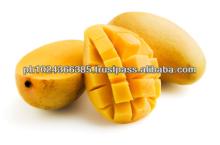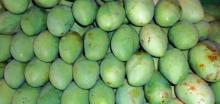
| ≥1 piece |
 |
Sweet mangoes.
Freshly picked.
No chemicals, all-organic.
Available all year.
Taste the fresh succulent and amazingly sweet Philippine mango and surely you will include it in your list of favorite fruits. It is also available as puree, juice and dried chips.
It’s our national fruit and we are honored to share it to foreign markets. It is also among the nation’s top three exported fruits-next to pineapple and banana.
We, Filipinos love eating the slice of a fresh sweet, succulent and ripe mango flesh. It also quenches our thirst as juice, puree, shake and as ice cream. Delicious and nutritious mango chips are wonderful snack option. This sweet mango also makes yummy refrigerator cake known as mango float which is my daughter’s favorite.
| | |
Another identification of a typical Filipino is when he/she enjoys eating green unripe mango dipped in bagoong or shrimp paste. The mixed sour and salty taste is so tempting and makes our saliva crave for more.
There are many varieties of Philippine mango grown in the country. However, the most famous variety exported is the “carabao” better known as Manila Super Mango. This mango is so sour when unripe and green but so sweet and pleasant smelling when ripe and yellow. It’s less fibrous and weighs more than 200 grams each. Top producers are Pangasinan, Negros Occidental, Isabela, Nueva Vizcaya and Zamboanga del Norte. There are other provinces contributing to the fruit production such as Guimaras, Davao, Misamis Oriental, Cotabato, Sarangani, General Santos, Ilocos, Cebu and Sultan Kudarat.
Guimaras is noted for producing the sweetest Philippine mango. They are even preserving the quality of their mangoes by imposing quarantine. Mangoes from other places are barred from entering Guimaras Island. Australia having tasted its sweetness prefers Guimaras-produced mangoes.
Foreign markets include Japan, Singapore, Hongkong, Korea, US, Australia, New Zealand, Canada, UK and Switzerland. On the other hand, foreign producers are India, the largest and whose national fruit is also mango, China, Thailand and Pakistan. The Philippine government is giving special attention to our mango industry for its development and growth.
Mango is a perennial plant that can live for 300 years or around four generations. The mature tree is quite big. It can be grown through its seed found in the middle part. It can also grow through grafting which is uniting a small part of a mature fruit bearing tree to a seedling forming the rootstock. Grafted plant bears fruit faster with quality of fruits similar to the original mature tree.
Flowering of mango plant can be induced naturally by vigorous smoking of its leaves. This method is true for backyard production. About half of the country’s mango production is from backyard raising with about 5 to 20 trees. The fruit induced through smoking is observed to be sweeter. The other method is through spraying potassium nitrate which produces more uniform flowering. In both cases, wrapping of two-month old fruit is practiced for pest and diseases protection and to produce spotless fruits.
Philippine mango is also a tropical fruit. It needs about four months dry season for better yield. Continuous rain will cause falling of flowers and rotting of small fruits. Peak mango production is during summer season. Ripe Philippine mango has relatively short shelf life. Thus, its preservation and processing into puree and dried chip forms, which are delicious and nutritious and have captured foreign tastes.
| Product Type: |
Tropical & Sub-Tropical Fruit
|
Type: |
Mango
|
Style: |
Fresh
|
| Variety: |
Guimaras
|
Color: |
Yellow
|
Cultivation Type: |
Organic
|
| Place of Origin: |
Philippines
|
 |
 |